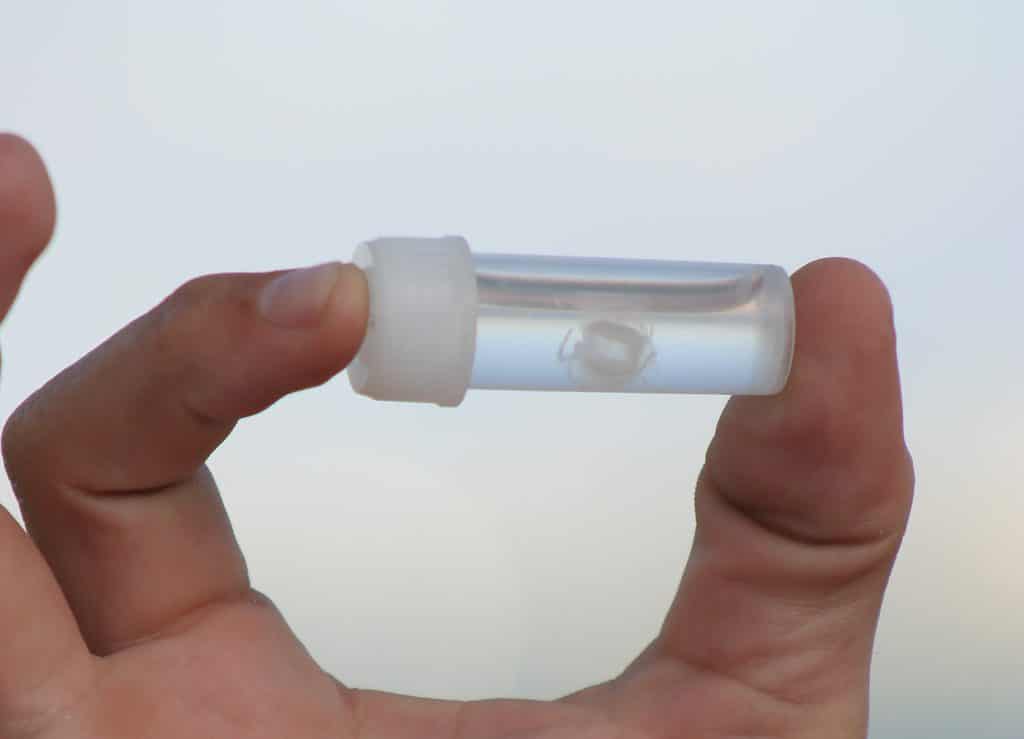The species was discovered when a scientist purposely got stung and stung his 9 year old son to study the venom
Advertisement
Irukandji Jellyfish Scientific Classification
- Kingdom
- Animalia
- Phylum
- Cnidaria
- Class
- Cubozoa
- Order
- Carybdeida
- Family
- Carukatiidae
- Genus
- Carukia
- Scientific Name
- C. barnesi
Read our Complete Guide to Classification of Animals.
Irukandji Jellyfish Conservation Status
Irukandji Jellyfish Facts
- Prey
- zooplankton
- Name Of Young
- Polyps
- Group Behavior
- Smack
- Fun Fact
- The species was discovered when a scientist purposely got stung and stung his 9 year old son to study the venom
- Litter Size
- up to 10,000
- Habitat
- Saltwater
View all of the Irukandji Jellyfish images!
The Irukandji jellyfish is a tiny sea creature, but don’t let the size fool you! If stung, this venomous jellyfish can cause extreme pain and even death.
Irukandji Jellyfish Summary
The Irukandji jellyfish, a rarely seen but dangerously venomous creature, is still one of the most mysterious sea creatures in the world. They are found in tropical waters and have a deadly sting that can cause extreme pain and even death if not treated in time.
Unfortunately, their tiny size makes them difficult to spot and avoid in the water, making them one of the most feared creatures of the sea.
Despite their treacherous nature, these beautiful little jellyfish are a source of fascination for many, and they play a vital role in the ecosystem.
5 Incredible Irukandji Jellyfish Facts
They are among the most venomous creatures on earth – but they’re also incredibly fascinating. Here are five incredible facts about these mysterious jellyfish:
- They are incredibly small – Irukandji jellyfish are so tiny they can barely be seen with the naked eye. They measure only 2 cm (or 0.78 inches) in diameter and can easily slip through nets used to protect swimmers from larger jellyfish species.
- They have complex, fascinating life cycles – starting as tiny larvae and can take up to 18 months to reach adulthood.
- They have eight eyes on their tentacles to sense the environment around them.
- Irukandji jellyfish are made up of 95% water and have no brain, heart, or muscles.
- They have some impressive natural predators – the only creatures that can withstand the powerful venom are sea turtles and some larger species of fish.
Irukandji Jellyfish Scientific Name
The scientific name for the Irukandji jellyfish is Carukia barnesi. This species was first discovered in the late 19th century, and it is still one of the most mysterious creatures of the sea.
It was named after an aboriginal Australian tribe called the Irukandji, which was known to have a deep understanding of the ocean and its dangers. And the latter part of the scientific name, barnesi, comes from Dr. Jack Barnes, who discovered this species. Barnes discovered this organism by purposefully stinging himself, his 9-year-old son, and the lifeguard with the jellyfish. Although this may seem crazy, the reason he did so was to find the culprit of the Irukandji syndrome. The Irukandji syndrome is what happens when you are stung by this particular jellyfish. Needless to say, he definitely found the culprit of this condition! Thankfully, all three survived the ordeal.
Irukandji Jellyfish Appearance

They are incredibly small – Irukandji jellyfish are so tiny they can barely be seen with the naked eye.
©2,221 × 1,606 pixels, file size: 596 KB, MIME type: image/jpeg – License
They are incredibly small and have an average size of 1 to 2 centimeters (or 0.4 to 0.8 inches). This makes them barely visible to the human eye, but their presence is still very much felt in shallow waters across Australian waters.
The Irukandji jellyfish has a box-shaped bell, which is usually transparent. It also has four tentacles that attach to the top of the bell. These tentacles can be anywhere from 5 cm (2 in) to 50 cm (20 in) long. These tentacles are covered in nematocysts, responsible for the jellyfish’s venomous sting.
The Irukandji Jellyfish has a distinctive, silvery hue on its body, usually in combination with white. In addition, its bell is often decorated with yellow or pinkish stripes and spots that give the jellyfish an eye-catching appearance – if you can spot it in the first place!
Irukandji Jellyfish Behavior
It is usually a solitary creature and can move quite quickly in the water. The jellyfish generally swims in shallow coastal waters, where it may, unfortunately, sting unsuspecting swimmers or divers.
In order to capture its prey, they releases venomous toxins through its nematocysts. This toxin can cause many symptoms, including abdominal pain, nausea, vomiting, and headaches. In severe cases, the toxin can even cause cardiac problems and neurological damage.
The Irukandji jellyfish can be active during the day and night. During the warmer months, they move closer to shore and can be seen near the water’s surface. During the colder months, they move away from the coast and deeper into the ocean.
One of the most interesting facts about the Irukandji jellyfish is that they are very active. Despite their small and fragile size, these jellyfish can swim at speeds of up to 1.5 meters per second, which is quite an impressive speed for such a small creature.
Irukandji Jellyfish Habitat
Irukandji jellyfish are found mainly in the tropical waters of Australia; however, they have also been spotted as far afield as Africa, the Caribbean, and even Hawaii. The species are found in waters of any depth between five and forty meters deep, and they can often swim as far as the shore.
They are attracted to areas with high levels of plankton, which is their primary food source. This is why they are often found in shallow waters near the shore, as it provides plenty of food for them to survive.
Due to their small size, Irukandji jellyfish can be difficult to spot in the water and often blend into the environment. This is one of the reasons why they are so dangerous, as it can be easy to accidentally swim into them, even if you don’t see them.
As a result, it is critical to be aware of the potential risks when swimming in areas where Irukandji jellyfish may be present.
Irukandji Jellyfish Diet
Irukandji jellyfish have a unique diet. It mainly feeds on zooplankton, which are tiny animals found in the ocean, like copepods and ostracods. They also feed on small fish and crustaceans. They can also snack on jellyfish eggs, although this is not a regular part of their diet.
Irukandji jellyfish can eat up to 10 times their own body weight in food each day! They use their powerful tentacles to poison and ensnare their prey and draw it into their bell-shaped bodies, where the food is broken down by digestive enzymes.
In addition to zooplankton and small fish, Irukandji jellyfish are also known to feast on the larvae of other jellyfish. This acts as population control and ensures there is enough food for the Irukandji jellyfish to survive and thrive.
Irukandji Jellyfish Predators and Threats
The Irukandji jellyfish has few predators, as its small size and potent toxin make it difficult for other animals to eat. However, ocean sunfish, along with some sea turtles, fish, and sea snakes, are known to prey on the Irukandji jellyfish.
Irukandji Jellyfish Reproduction
The reproductive cycle of the Irukandji jellyfish is quite fascinating. The jellyfish reproduces by releasing either its eggs or sperm into the water. Fertilization occurs when a male’s sperm meets a female’s egg. After fertilization, the eggs quickly develop into planula larvae, which are small and ciliary and can swim freely in the water.
The planula larvae then attach themselves to a hard surface, like rocks or coral, and develop into polyps. The polyps then reproduce asexually and form many tiny jellyfish, which eventually become adults.
The Irukandji jellyfish reproduces quickly and can produce over 10,000 offspring in one season. This ensures that the species can survive and thrive despite its small size.
Irukandji Jellyfish Sting
The Irukandji jellyfish is notorious for its potent sting and the effect that venom has on humans. The venom of the Irukandji jellyfish is incredibly powerful, and in some cases, it can even be fatal if the person does not receive prompt medical attention.
The venom is incredibly complex, and scientists are still trying to understand the components of the venom and how it works. It contains a combination of neurotoxins, which are toxic to the nervous system, and cardiotoxins, which can be damaging to the heart.
The sting of the Irukandji jellyfish is often followed by a reaction known as Irukandji syndrome. It can include severe back and abdominal pain, nausea, vomiting, sweating, dizziness, anxiety, and even psychological symptoms.
Irukandji Jellyfish Lifespan
No one knows for sure how long an Irukandji jellyfish can live. It is estimated that they may live up to 5 years in the wild. The species’ lifespan is likely to be shorter in captivity. They do not have access to their natural food sources and may be subject to other environmental factors.
Irukandji Jellyfish Population
Irukandji jellyfish and their incredibly venomous sting have been around for ages. Scientists are still researching how to best protect them while avoiding them. Due to a lack of data on population numbers and distribution, their conservation status is currently listed as “Least Concern” by the International Union for Conservation of Nature (IUCN).
Their total population is not know. It is difficult to monitor them accurately due to their small size and venomous nature. But it is growing rapidly in the coastal waters of Australia, with recent reports indicating a sharp increase in numbers. With its ability to reproduce huge numbers at once, their numbers are not likely to decrease any time soon.
Similar Animals
- Blue-ringed octopus: This is a tiny octopus species that is surprisingly incredibly dangerous – even to humans. This octopus species is known to paralyze and kill humans with its venom.
- Immortal jellyfish: A species of jellyfish that can live forever, the immortal jellyfish has incredible regenerative abilities.
- Stonefish: One of the most venomous fish in the world, this fish can hide from predators by camouflaging.
- Box jellyfish: This species of Australian jellyfish overtakes the Irukandji jellyfish in terms of deadliness.
Irukandji Jellyfish FAQs (Frequently Asked Questions)
How common is the Irukandji jellyfish?
The Irukandji jellyfish is far less common than other species of jellyfish. It is most often found in tropical waters, with temperatures between 22 and 25 degrees Celsius. In Australia, it is especially common off the coasts of Queensland and the Northern Territory.
What are the dangers of the Irukandji jellyfish?
The sting from an Irukandji jellyfish can be incredibly painful and even fatal in some cases. Symptoms of an Irukandji sting may include severe abdominal pain, backache, headaches, muscle cramps, and difficulty breathing.
How can I avoid being stung by an Irukandji jellyfish?
To avoid being stung by an Irukandji jellyfish, it is important to be aware of their presence. If possible, avoid swimming in areas where they are known to be common.
Can Irukandji jellyfish sting humans?
Yes, the tentacles of the Irukandji jellyfish can deliver a very painful sting to humans, which can be followed by severe reactions.
What do Irukandji jellyfish eat?
Irukandji jellyfish feed on small zooplankton and other small fish and crustaceans. They can also feed on the larvae of other jellyfish.
What animals eat Irukandji jellyfish?
Currently, the only known animals that can safely consume Irukandji jellyfish are ocean sunfish, some sea turtles, and a few other fish species.
Thank you for reading! Have some feedback for us? Contact the AZ Animals editorial team.
Sources
- , Available here: https://animaldiversity.org/accounts/Carukia_barnesi/
- , Available here: https://study.com/learn/lesson/irukandji-jellyfish-habitat-facts.html
- , Available here: http://bioweb.uwlax.edu/bio203/s2013/lyons_kels/nutrition.htm
- , Available here: https://www.barrierreefaustralia.com/info/reef-dangers/Irukandji/
- , Available here: https://nt.gov.au/wellbeing/emergencies-injuries-and-accidents/bites-and-stings/box-jellyfish
















